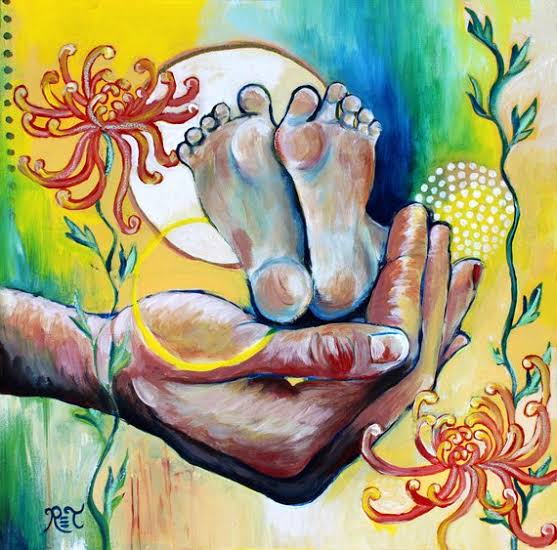Posted by Sugandhaa Pandey
Since the advent of linguistic civilisation, the ability of humans to reproduce has been used as a metaphor for artistic creativity. Philip Sidney’s Petrarchan sonnet, Astrophil and Stella (sonnet no XV, 1591) has been often quoted to illuminate this tradition:
“Thus great with Childe to speake, and helplesse in my throwes,
Byting my tongue and penne, beating my selfe for spite:
Foole saide My muse to mee, look in thy heart and write.”
Here, Sidney compares the pain and labour involved in artistic creativity with childbirth. It is a debatable metaphor comparing female procreation with male pregnancy resulting in the production of artistic and literary creation. It establishes an analogy between phallus and the ‘pen’ and/or ‘paintbrush’ thereby, excluding women from the realm of artistic creativity. Reverberations of this thought within the Indian context are found in the ancient Sanskrit text Manusmriti which states, “Of the seed and the womb, the seed is superior. All creatures of life assume the qualities of the seed.”
Feminists arguing in favour of metaphor of childbirth claim that it supports the artistic attempts of a woman by accepting the creative mental faculties as an extension of their physical procreative labour. Feminists arguing against it state that confining women to a life of the primary care-giver diminishes and curbs their freedom of artistic expression. It reduces women to baby-making machines.
This controversy of difference in opinion is based on the fact that while women have been given the credit for procreation, they have not been given proper recognition and opportunities for their artistic ambitions.
This controversy of difference in opinion is based on the fact that while women have been given the credit for procreation, they have not been given proper recognition and opportunities for their artistic ambitions. Nasadiya Sukta, also known as the hymn of creation, states, “mánaso rétaḥ prathamáṃ yád ā́sīt”, i.e., “the primal seed was born out of mind”. This hymn has been misinterpreted by some as, women are creatures of passion/desire and men of mind; since thought precedes desire therefore, only men possess the quality of ‘creative genius’. Women have been allotted the private sphere, i.e. domestic lifestyle, and their artistic talents have been discouraged into oblivion. This systematic seclusion of women from the realm of art has been practiced under the belief that motherhood is an art. Is motherhood an art?
Also read: Why Motherhood May Not Be For Me
The attempt to liken the womb of creation of life with the womb of imaginations is unreasonable. A pregnant body is necessarily female. On the other hand, a pregnant mind is the province of a genius hence, historically it is necessarily male. The accordance of public and private sphere of life to man and woman (respectively) is a restoration of these ideas since a child is conceived in the womb while, an idea in the mind. Further, end of the gestation period for a woman releases her into the bonds of maternity but, delivery for a man refers to the restoration of his autonomy.
The attempt to liken the womb of creation of life with the womb of imaginations is unreasonable. A pregnant body is necessarily female. On the other hand, a pregnant mind is the province of a genius hence, historically it is necessarily male.
The internalisation of motherhood into womanhood has percolated within the Indian social construct through art, myths, and folklore. Since art is said to be born out of religion hence, the earliest imagery of Mother or Devi Maa is found in the terracotta art of the Indus Valley Civilisation during 2000 BC. On the other hand, one has never heard procreational adjectives being attached to the male divinity. Male deities with vows of bachelorhood are celebrated but a parallel example of female deity is nowhere to be found. While some count this adoration as a strength of our culture, I wish to question how much of this adoration is transferred to the mothers in their lives? The epic matriarchs of The Mahabharata – Kunti and Gandhari had their individual identities entirely encompassed by motherhood. This internalisation is so strong that it has colonised our minds to an extent that finding fellow-female support on the subject of not-being-a-mother is a rarity.
A woman is never settled in her life unless she is a married mother. The psychological oppression entailed by such societal expectations has dire consequences. Infertility or choosing not to be a mother leads to a fear of a cheating husband or being a failure as a woman, respectively. An ambitious woman who chooses to nurture a satisfying career for herself by manoeuvring through social stigmas attached with her identity, even if child-less, is no less of an artist in my opinion. Our tendency of romanticising the sacrifices our mothers make by annihilating their individual identity in order to be ‘good mothers’ is a consequence of gendered expectations. Not all women have motherly affections stimulated within them at the prospect of turning into a mother in real life. A woman can revel in the aesthetic pleasures arising out of activities related to motherhood but, such pleasures shouldn’t be restricted to childbirth.
The complex biology of the female form is the fundamental basis of the existing sexual dimorphism. A practicalist view shall help us in challenging the linguistic hegemony that oppresses women. Motherhood needs to be understood as an aim – fulfilling the demands of a child in her/his formative years when the child is most vulnerable. It is an experience of caring for someone you love. Foster parents, an elder sibling, a distant relative, or a close friend – anyone can play that role for a child.
Also read: How Serena Williams Is Revolutionising Motherhood In Sport
Motherhood needs to be freed from being tied to its physicality alone. Objecting against the traditional viewpoint, I believe role of a father is equally important in a child’s life as that of a mother. Mothering should not be determined by the gender of the person catering to the needs of a child. Hence, the correct meaning is reflected in the gender neutral terms – ‘parenthood’ and ‘parenting’. Is Parenthood an art? I believe so.
Sugandhaa is a masters in Philosophy from LSR. Her major areas of interest are feminism, art, and aesthetics. She enjoys engaging with historical fiction – when she isn’t reading it, she is daydreaming about it! You can find her on LinkedIn.
Featured Image Source: Etsy
About the author(s)
Sugandhaa's major areas of interest are aesthetics and feminism. She loves engaging with historical fiction - when she isn't reading it, she is daydreaming about it!






I am looking forward to an empirical study of Indian women and men on this issue. I agree with you in totality but there are several women who believe that its mostly a childless woman who thinks so and its only the birth of a child that will make one understand the essence of motherhood. How will you explain this? How can we draw conclusions on something that we havent experienced?
Thank you for a very logical argument. As a student of Philosophy I have been taught that there are two ways (broadly) of attaining knowledge – reason and experience. So I do not feel that we should keep experience the basis of everything. In such a case, hypothesis generation would become impossible.
Further, my article aims for solidarity for women who give importance to (say) their career over motherhood, or those who can’t bear children and are shunned by the society or bear the brunt of name-calling.
Also, this article in extension seeks to give recognition to women as artists beyond their ability to procreate. This would be better understood when one studies the limitations imposed on women restricting them only to the private sphere of life.
Well written! It questions one of the oldest stereotype which has existed in the mankind with a beautiful mix of words and the author’s wisdom.
I do hope to read more such content.
Thank you for your appreciation. I hope to keep writing similar content.